Note: The location of the parts of the refrigeration unit is shown in illustration 8.2. Description of sensor replacement "G263" evaporator temperature is given in Section 14.
Note: On models with condenser "Denso" The receiver and dryer are part of the condenser and cannot be replaced separately. On models with company parts "Showa" And "Fujikoki" the receiver is replaced together with the desiccant cartridge. On models with parts "Modine" the receiver is part of the condenser, and the dryer can be replaced separately from them. Replacing the receiver-drier is required only after: the compressor has been stuck, the refrigerant circuit has been open indefinitely (for example, with long-term coloring) or the coolant circuit has been bled.
1. With cover (3 on resist. illustrations) expansion valve to remove it, disconnect the coolant lines from the heater radiator, give the nut (1) and remove the fasteners (2). When installing, tighten the nut to 6 Nm.
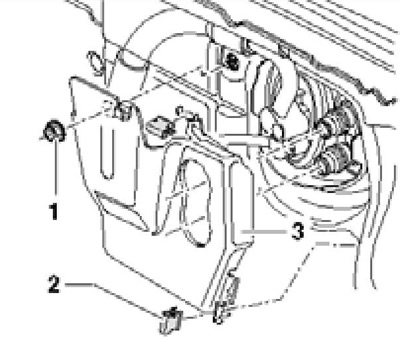
18.1 Fixing the expansion valve cover
Removal and installation of the expansion valve
2. On some engines, it may be necessary to remove the engine top cover to gain access to the expansion valve (see chapter 2), turbocharger inlet hose, particulate filter cover and air cleaner inlet hose (see chapter 4).
3. Drain the coolant.
4. If present, remove the expansion valve cap (see paragraph 1).
5. Turn out bolts (1 per resist. illustrations) and separate the refrigerant lines from the expansion valve (2). Remove the bolts (9) and remove the expansion valve from the thermal insulation (6). When installing, use new O-rings for the refrigerant lines.
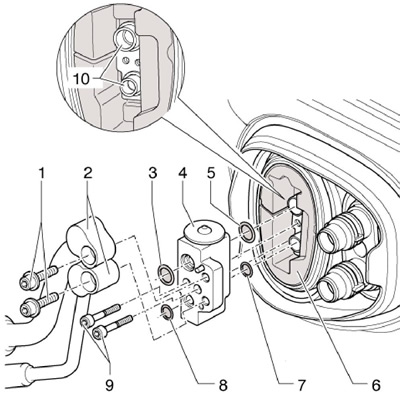
18.5 Expansion valve installation details
1 Bolts, 12 Nm
2 Refrigerant lines at expansion valve
3, 5, 7, 8 O-ring
4 Expansion valve
6 Thermal insulation
9 Bolts, 5 Nm
10 Evaporator connections
Capacitor
6. Drain the refrigerant from the refrigeration unit.
7. Remove the hood latch holder (see chapter 11).
8. Disconnect the refrigerant lines from the condenser (see illustration 8.2) and seal them up.
9. Turn out 4 bolts and remove the condenser from a radiator (1 per resist. illustrations).
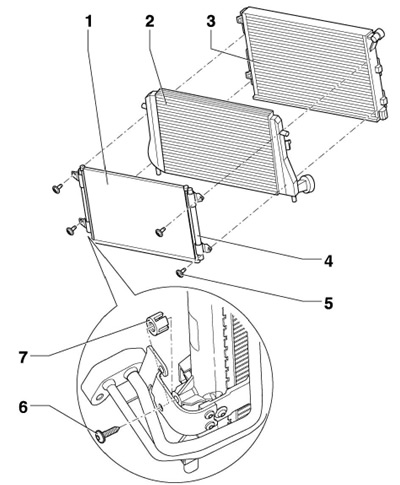
18.9 Condenser and receiver-drier installation details
1 Capacitor
2 Intercooler
3 Radiator
4 Receiver dryer
5 Bolts, 4 pcs., 5 Nm
6 Bolt, 5 Nm
7 Support, on some models
10. Installation is carried out in the reverse order.
Replacing the desiccant cartridge ("Showa" And "Fujikoki")
11. Drain the refrigerant from the refrigeration unit.
12. Remove the hood latch holder (see chapter 11).
13. Without disconnecting the coolant hoses, secure the condenser with wire.
14. Turn out a bolt (1 per resist. illustrations) and remove the clamp (2). Then unscrew the bolts (5) and pull out the receiver with the dryer (3) up.
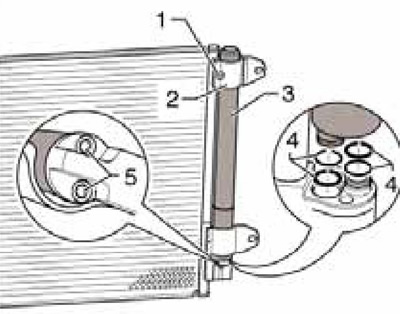
18.14 Replacing the desiccant cartridge ("Showa" And "Fujikoki")
15. Installation is carried out in the reverse order. Use new o-rings (1 in illustration 18.14). Tighten the bolts first (5), then bolt (1) with a force of 5 Nm.
Replacing the desiccant cartridge (capacitor "Modine")
Note: It is not necessary to replace the cartridge every time the refrigerant circuit is depressurized for a short time if the vehicle is less than 5 years old.
16. Remove the front bumper cover (see chapter 11).
17. Remove the plug (1 per resist. illustrations) and drain the refrigerant from the refrigeration unit.
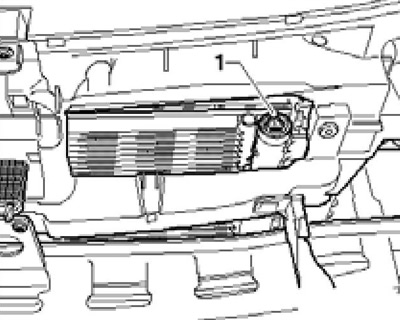
18.17 Cartridge plug
18. Push in the sealing cap (1 per resist. illustrations) into the receiver, remove the retaining ring (arrow) and pull the sealing cap out of the condenser (2) with an M12 bolt.
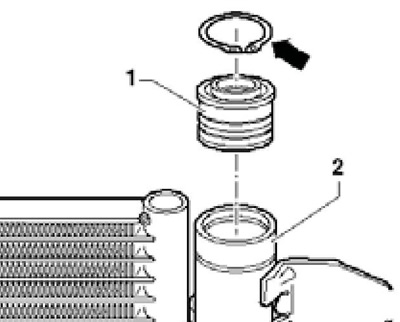
18.18 Sealing cap (1)
19. Remove the desiccant bag from the condenser using a suitable tool (see resist. illustration).
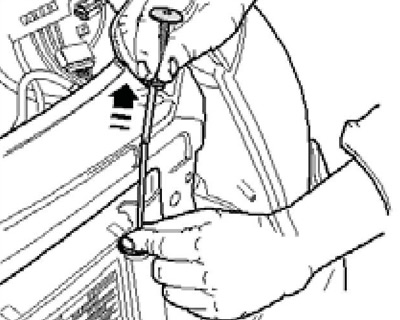
18.19 Removing the desiccant bag
20. Bend the end of the 2mm 380mm welding rod into a 6mm hook (1 per resist. illustrations) and remove the cartridge (2) from the condenser.
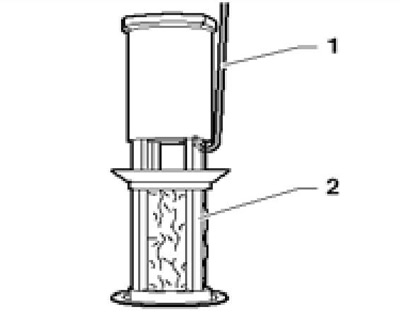
18.20 Removing the evaporator cartridge (2) using a curved electrode (1)
21. Insert a new cartridge into the condenser and then insert the desiccant bag into the condenser.
22. Further installation is carried out in the reverse order.
Evaporator
23. Remove the climate system housing and disassemble it by removing the evaporator from its lower casing (see Section 15).
24. Before installing the evaporator, check the patency of the drain hose and, if necessary, clean it.
25. Make sure the seal is (F on resist. illustrations) worn around the perimeter. Put on connections (D and E) holder (WITH) with seal (IN) and insert the evaporator (A) into its lower case as shown in the illustration. When doing this, and also when installing the top cover, be careful not to damage the seal (F). After connecting the shrouds, check the correct position of the shrouds.
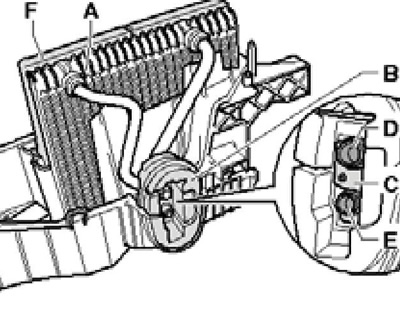
18.25 Evaporator seal parts
